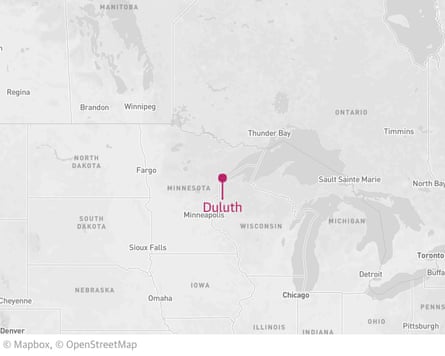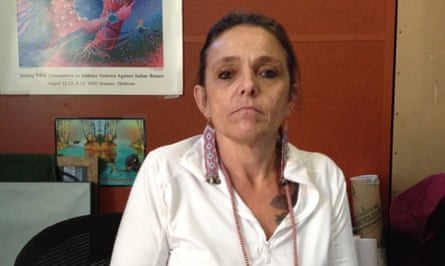A recent spate of cases involving Native American women from northern Minnesota being murdered or going missing has raised questions about how seriously such disappearances are taken by the police and other authorities.
As Duluth, Minnesota, marks trafficking awareness month, local activists say some of the disappearances and deaths are linked to this issue, and argue that the invisibility of the Native American population contributes to neglect by police, media and social services and point to the need for better data collection in order to track the number of missing and murdered women.
Three Native American women have been killed and two more have disappeared from northern Minnesota since May last year.

Lisa Isham, 52, Dawn Reynolds, 44, and Rose Downwind, 31, were all found murdered in northern Minnesota between May and December.
Two other Duluth women went missing, one of whom has since been found, while the other, Sheila St Clair, 48, has not. In April, a third Minnesota woman, Edith Chavez, was abducted in North Dakota, but managed to escape.
“I think a lot of disappearances of young women can be tracked back to some sort of trafficking,” Patti Larsen of Mending the Sacred Hoop, an organization focused on ending violence against Native women, said.
Chris Stark, a researcher focusing on sex trafficking on the ships in Duluth’s port, agreed. “There’s a connection between like the reservations and places like Bemidji and Duluth and the Twin Cities [Minneapolis/St Paul] in terms of the trafficking and prostitution routes that are run,” he said.
“It’s definitely an issue, and even the Native teenage girls that are being recruited or groomed from the Duluth area to go out to the Bakken.”
The Bakken is an oil-rich area in western North Dakota that attracted tens of thousands of male workers within a few years to respond to the oil boom there in the late 00s.
Advocates such as Larsen and Stark contend that Native women and girls represent an easy target for traffickers who seek to recruit them into commercial sex work. According to federal data, Native women are twice as likely to be sexually assaulted as women of other races. They are also subject to high rates of intimate-partner violence and other forms of violence. These factors, along with poverty, substance abuse and foster care, can make them vulnerable to exploitation.
One result of such vulnerability, advocates say, may be that Native women are disproportionately drawn into trafficking compared to other groups. A 2007 review of probation records from North Minneapolis found that 24% of the women charged with prostitution in that area were Native American, yet they only comprised only 2.2% of the population.

Thirty miles west of Duluth, amid snow-crusted pine trees and meadows, lies the Fond du Lac reservation. For Nikki Crowe, 44, a resident of the reservation, there are common misconceptions. “Most of the time trafficking isn’t like the movie version of trafficking where a child is snatched off the streets. It’s more like, we’ve already been [violated] in so many ways, from historical trauma, to the addiction, to the sexual abuse that we don’t talk about as communities, to the things that have happened at the boarding schools and the breakdown of our communities and our families.
“We’re already so vulnerable that perpetrators see that we’re so easy to victimize. So it might just be a man saying the things that we want to hear that lead us away.”
Native American women also face the challenge of being believed by authorities.
Last April in Casselton, North Dakota, Edith Chavez, 38, of Tower, Minnesota, was abducted and, she suspects, drugged for a few days before managing to escape from the back of her abductor’s car when she found him absent.
When Chavez arrived at the police station in Williston, North Dakota, she says officers refused to take a statement, and instead checked her own record. They arrested her for an unpaid traffic ticket dating from 2011 and detained her overnight in a holding facility before transferring her to a jail in Minot, North Dakota. There, a female officer recognized something was wrong, had Chavez’s charges dismissed and gave her directions to the closest hospital.
The Williston police department did not respond to requests for comment. But it issued a press release in June claiming Chavez had smelled of alcohol and had been to a casino, points not noted in the day log or the Uniform Incident Report registering Chavez’s arrest.
“It’s pretty much ignored when Native women go missing,” said Carmen O’Leary, who runs the Native Women’s Society of the Great Plains, a tribal coalition that focuses on issues of domestic violence, sexual assault and sex trafficking.
She cited the examples of Robin Fox, who was found dead after going missing.
“If there had been an immediate search, they might have found her before she died” – and Vicki Eagleman, a mother of five. “She was found, deceased, after 30 days of being missing and nobody willing to take a report.” (O’Leary said she didn’t believe either case was related to trafficking.)
Chad Johnson, a detective with the Three Affiliated Tribes tribal police, said that they followed protocol at the time Fox went missing. He said they didn’t order a search right away because they had other procedures to follow.
The tribal police could not be reached for comment regarding the Eagleman case.
Duluth police officer Kim Wick said she received hundreds of missing person reports each year, yet the way the department processes its data made it challenging to identify how many cases involved Native women, and how many were connected to trafficking. The department recently received a grant to support Wick’s work by providing another officer who will focus on minors and help organize the relevant data.
“There’s a lot of kids who don’t get reported,” said Wick. “The victim-survivors are isolated.
“It’s part of the grooming process, and they can be transient, so they often go unreported.” Further complicating matters, Wick said many women involved in commercial sex have had negative experiences with law enforcement officials and are thus unlikely to seek help from police.
While tough conditions on reservations may be one factor pushing women into trafficking, Larsen said that disappearances and trafficking often coincide with other phenomena such as gang activity on reservations, oil drilling in North Dakota or ships entering Duluth’s international port. “Follow the pipeline through, you follow the construction workers, you follow the money, you follow the oil – you’ll start seeing where the trafficking will follow that,” she said.
Duluth’s international port on Lake Superior has served as a hub for commercial sex for decades, said Stark, taking advantage of the proximity of low-income Native women from surrounding reservations. “It is like a built-in pool of women who’ve had a lot of barriers in their lives: educational barriers, racism, high rates of homelessness.”

She says that hunger often pushed these women to accept invitations to “parties” on the ships. Stark said that the parties were presented as a good time with lots of food and drink, but that women were not always aware that they would be expected to provide sexual services. What’s more she said, the “parties” could have even more serious consequences. “[The sailors] will ply [the women] with alcohol, and they’ll wake up and they’ll be on their way to Thunder Bay [in Canada] listening to someone talking about who they’re going to sell them to.”
While Larsen and others in Duluth said that trafficking on the ships had decreased since security was tightened in the port after 9/11, they did not believe that it had been eliminated entirely.
At a recent hearing in Thunder Bay on indigenous women’s safety, more than one family presented concerns about female relatives who disappeared after visiting the ships, according to Canadian indigenous affairs minister Carolyn Bennett. “Like we’d heard during Idle No More [a Canadian movement for indigenous rights], they [indigenous women] went to the ships, then they disappeared.”
After years of pressure from First Nation groups, in 2014 Canada released a report that found that 1,017 First Nation women had been murdered and 164 had gone missing between 1980 and 2012.
In Duluth, Nigel Perrote of PAVSA, a local organization focused on eliminating sexual violence, cautioned that not all disappearances were linked to trafficking. “If they’re involved in a domestic situation and they know that the tribal police or the county police are not stepping in to protect them, they may see their only way out as leaving and going to another area.”
Yet he also agreed with O’Leary that when Native women did disappear, their cases were often overlooked. “When you look at the media, often times it’s a white woman, often times younger and college-aged that is getting the attention, and not a middle-aged Native woman who may have a criminal history because I think people can relate more to [the young woman]; whereas maybe they can’t relate to a Native person or pretty much any person of color that has gone missing.”
Adele Yorde, a spokeswoman for the port in Duluth, acknowledged that disappearances and trafficking disproportionately affect the Native community, but said that the port was trying to eliminate trafficking on the water and to help raise community awareness. It is part of Duluth’s sex-trafficking taskforce, and held a training exercise last year with 65 terminal operators and their security staff to identify potential trafficking situations.
“It’s difficult in an industry that hasn’t heard any charges brought, any active investigations opened, to know that there is anything going on,” she said. “But if there are stories being told, [we are] trying to discern what are some of the issues of 2001 and before, and what are some references that are still being made. So we’re really working hard to stay part of the dialogue.”
